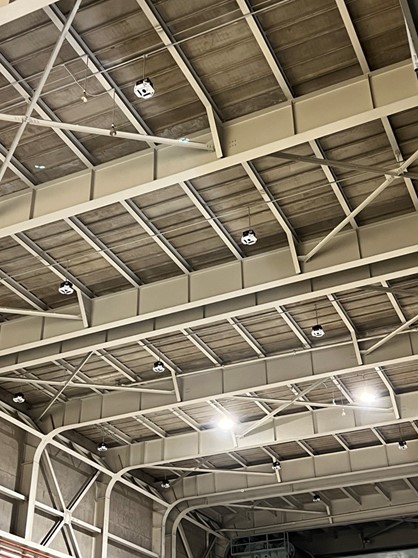 The newly installed lights luminate the Glen Canyon machine shop.
The newly installed lights luminate the Glen Canyon machine shop.
By: Amee Andreason and Riley Martin
Reclamation, like all other federal agencies, is required under the Federal Building Performance Standard to cut energy use and replace fossil-fuel systems and appliances with efficient, non-pollutive electric equipment and appliances in buildings owned by the federal government. The goal is to achieve zero emissions in 30% of the buildings by 2030.
Why exactly is this important? Because buildings are a major source of greenhouse gas emissions in the United States and fossil fuels used in federal buildings account for over 25% of all federal emissions.
The Upper Colorado Basin Region is committed to taking the necessary steps to reduce our carbon footprint, whether it is construction of a new project or updating existing facilities. A few of these modernization projects have recently taken place at the powerplants at Glen Canyon and Flaming Gorge.
Glen Canyon was awarded $153,000 in funding for water and energy improvements to replace 84 high bay lighting fixtures in the generator gallery as well as the machine shop. This move from metal halide bulbs to 485-watt LED lights is projected to save the powerplant approximately 809 megawatt-hours per year. For reference, 809 MWh is enough energy to support 77 households for an entire year. The efficient lighting not only saves energy, but also saves money.
Beyond the obvious energy savings of this switch, LED lights also produce about half as much heat as the original bulbs, heat that then needs to be removed by the powerplant refrigeration system to sustain safe operations.
“Making the switch to LED lights was an obvious choice for us, as it is just a more efficient way to run our facility,” said Glen Canyon Field Division Manager Gus Levy. “Not only do we save energy, we also have better quality lighting.”
A similar lighting retrofit at Flaming Gorge Dam and Powerplant replaced 27 metal halide 1,000-watt high-bay lights with 480-watt LEDs, cutting annual energy consumption from 236,520 kilowatt-hours to 113,530 kWh.
“The energy efficiency and considerable lifespan of LED lighting was simply a smart choice as it helps brighten the facility and reduces the cost of electricity and overall energy use,” said Flaming Gorge Facility Manager Roxann Reid. “As a producer and wholesaler of power, it’s extremely important that we help reach the efforts outlined in the federal standard.”
After the installation of the LED lighting, the Flaming Gorge Field Division decided to go a step further and install timers on the powerplant’s high bay lights, allowing them to fluctuate on and off. Instead of all the high bay lights on at once, now 15 lights are off for 13 hours on Monday, Tuesday, Wednesday and Thursday and off for 24 hours on Friday, Saturday, Sunday and holidays while keeping enough lights on for safety and security. This took the powerplant high bay lighting from using 2,177 kWh a week to 1,284 kWh a week. A total of 169,416 kWh of green renewable energy is now available to the grid annually.
Flaming Gorge next plans to replace the 324-watt lamps with 78-watt lamps throughout the entire powerplant, visitor center and warehouses to make the facility more energy efficient than ever before.
As the federal government is the country's single-largest energy consumer and building manager, actions like this will save taxpayer dollars by reducing energy use while cutting millions of tons of greenhouse gas emissions. It is important for us to make these environmentally responsible choices now to benefit generations to come.



